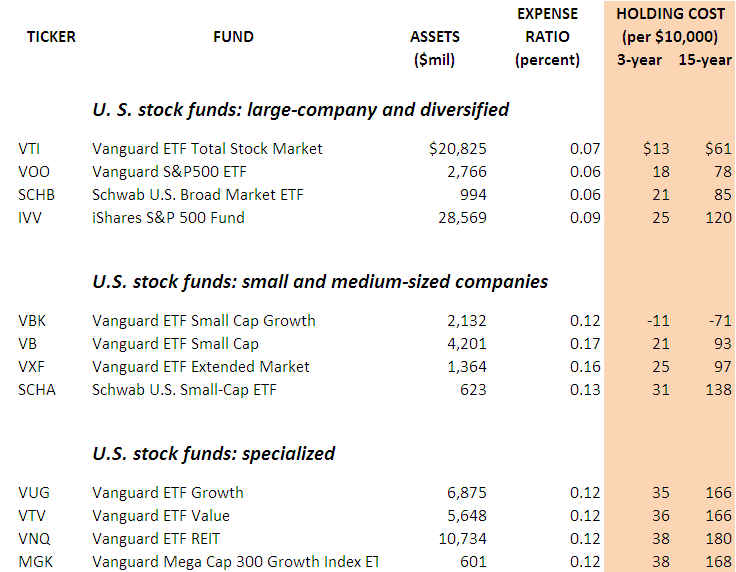The Best ETFs For Investors
Post on: 12 Июль, 2015 No Comment

Follow Comments Following Comments Unfollow Comments
The online scorecard reflects securities lending data presented to Forbes after the deadline passed for inclusion in the magazine article .
Good news for savers: There’s a price war in exchange-traded funds. If you know where and how to get your hands on the bargains, you can enhance your wealth by tens of thousands of dollars. This annual survey of all-star ETFs, our second, will steer you to the best deals.
Our ratings are based on long-term holding costs, so expense ratios count much more heavily than liquidity. The heavily traded SPDR Gold Shares (GLD) squeaks onto the winners’ list but doesn’t look as cheap as the competing product from BlackRock, the iShares Gold Trust (IAU). In big-company funds Vanguard and Schwab share the top four spots; the better-known SPDR S&P 500 fund (SPY) doesn’t make the list.
We rank the funds on a unique measure of cost efficiency that looks at expense ratios, securities lending revenue and trading spreads. On our scorecard there are funds so efficient that their cost is negative–you do better with them than you do owning the component stocks. The funds accomplish this magic by lending securities to short-sellers for a fee and kicking the proceeds back into the pot, lowering the effective cost of ownership below zero.
ETFs were invented 20 years ago with the notion that a few institutional traders might like a way to temporarily hold fixed baskets of stock, like the 500 that make up the main S&P I ndex. The category has exceeded all expectations, with $1.5 trillion in assets in the U.S. The granddaddy fund, the SPDR S&P 500 ETF, holds $130 billion of stock and sees $20 billion of its own shares change hands on an average day.
It may be no surprise, though, that Wall Street has managed to turn something that should be simple and cheap into a bewildering collection of choices. There’s a new ETF that combines junk bonds with a complicated interest-rate hedge. Do you need that?
Among the 1,255 ETFs that pop up on Fidelity’s screening tool is one that just buys small real estate investment trusts and another that owns sugar futures. Tickers: ROOF and CANE. Cute–and maybe useful, if you have a particular hedging need.
This Best ETFs survey, though, is aimed not at speculators or hedgers but at long-term savers. If you want to put away a chunk of money for three decades, an index fund is an excellent choice, and one thing ETFs can do well is give you exposure to just about any stock or bond index.
The original ETF, the SPDR S&P 500 from State Street, looks pretty cheap, with an annual overhead of nine basis points, or $9 per $10,000 invested. But you can do better. Penny-pinching Vanguard offers a knockoff S&P 500 fund costing five basis points. ETF upstart Charles Schwab & Co. has a variation on the theme (750 stocks rather than 500) that costs only four basis points.
If you are investing on your own, such as through an IRA, getting access to bargain ETFs is as simple as opening a self-directed account at any of the numerous brokers that offer these on a no-fee basis. ETFs trade on the New York Stock Exchange and various electronic competitors.
If you are investing through a 401(k) there’s another step involved. You have to use the plan’s brokerage window, an option offered by about a third of large employers. (Your plan doesn’t have the window? Complain.) If there’s a fee for using the window, wait until your account hits six figures.
How much you can save with this trick depends on which funds you are getting out of. Are you invested in an actively managed portfolio? Your 401(k) operator may have lured you into one. Chances are any actively managed fund is costing you more than half a percentage point in fees annually, perhaps a lot more.
Sell the expensive fund.
Construct your own blend of stocks and bonds, using the cheap ETFs that score well in our survey.
Consider someone putting in maximum 401(k) contributions over a long career, earning a real return of 3% and getting a $5,000 company match. That account would grow to $1.9 million at retirement. (That’s in today’s dollars.) The same saving effort, damaged by an extra half a percentage point in annual investing costs, is going to deliver $200,000 less.
Say, that would pay for a nice little vacation home. Why let the broker have it?














